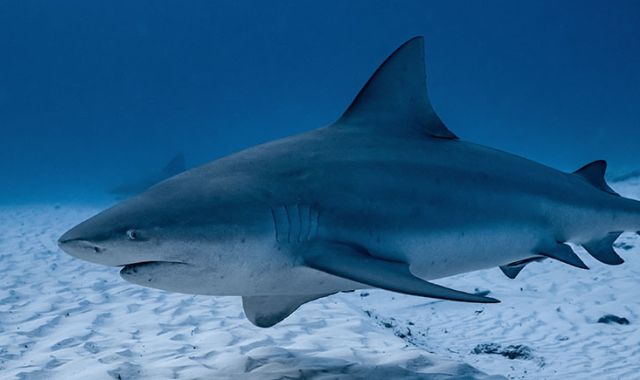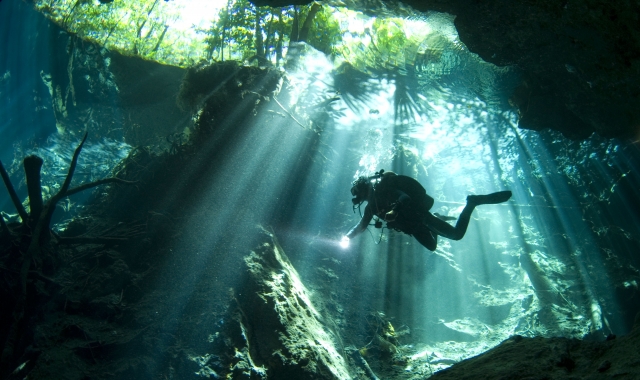- More More
- Blog
- Inspire me
- Groups
- Offers More
- Dive Courses More
- Liveaboards
More

Liveaboard Trips
On-board accommodation offering the opportunity to live right over the dive sites and to experience secluded dives...
Diving regions...
- LATEST AVAILABILITY BY REGION
- Red Sea availability
- Maldives availability
- Indonesian availability
- Socorro Mexico availability
- Galapagos availability
- ALL LIVEABOARD DIVING REGIONS
- Bahamas
- Bikini Atoll
- Caribbean
- Cocos Island
- Destinations
MoreDIVING REGIONS...
Our Top destinations....Why not try....
Find a trip
- Resort
- Liveaboard
Dive with Bull Sharks in Mexico

20 Feb 2025
The name bull shark comes from the short, blunt snout and their strange inclination to charge (head-butt) their pray before attaching. At over three metres in length and thick bodies, bull sharks sightings in Playa del Carmen are a true diving highlight of the area. These, mostly female and usually solitary, apex predators come together to what is understood to be a breeding ground for the sharks.
At this time of year, the weather is usually at its calmest and the cloud level is minimal, both of which make it an ideal time to dive the Cenotes and Cozumel. Playa del Carmen is an excellent base for exploring the Yucatán Peninsula and is a more affordable and accessible area compared to other bull shark experiences global.
Diving with bull sharks is only possible on special trips, which are organised by highly trained instructors to ensure the utmost safety and environmental responsibility. Divers on these trips also take part in a special education programme and need to have a minimum certification of advanced plus 25 logged dives. Two local check dives must be undertaken prior to the bull shark diving trip.
If you’re interested in joining a bull shark adventure, please contact us for more details of our Mexico dive holidays.
Thanks to our partners in Mexico for this amazing video!
Find a trip
- Resort
- Liveaboard
John Butland's Socorro Islands Trip Report
11 Jan 2017
John shares his Socorro Islands trip report with us here:
There are times when all of us will realise that we have witnessed something very special indeed. One of those times for me was my recent trip to The Revillagigedo Islands, 250 miles into the Pacific off the west coast of Mexico. The name might not mean too much to you, don't worry I don't know how to pronounce it either, so they are more often referred to by the name of one of the four islands, Socorro.
Now, like a lot of locations where we divers want to get away from the rest of the non-diving world, they do take a bit of getting to. It started with a flight from the UK to the tip of the Baja peninsula, via Mexico City, which was overnight, so no worse than getting to other worthwhile places, like Indonesia. After an overnight in a harbourside hotel, I joined the Nautilus Under Sea, my home for the next eight nights. It proved to be a very comfortable boat with a friendly and knowledgeable crew. I was very happy as it had great food too!
The journey to the islands takes about 24 hours, so all of the first night and all of the following day, so there was plenty of time to get to know my 13 companions for the week. But that's what makes it so attractive. These are uninhabited islands (apart from a small Mexican Navy outpost), with no hotels and no airport, so only divers can go there!
The first dive was at The Canyon, at our first island, San Benedicto. We all knew straight away that it was going to be a great week for sharks, as we saw four different species on that first dive, Silkies, Whitetips, a couple of Silvertips and a lone Hammerhead patrolling the reef edge. Not bad for a check dive!
We were all pretty pleased that the crossing had been nice and calm. This meant that we also could make another, shorter, transit to an even more remote location, Roca Partida. Just a lump of rock sticking out of the ocean, 300 miles from the mainland. Not much to look at above the water, with no vegetation and white with bird deposits, but its beauty lies beneath. The rock continues almost vertically downwards for about 80 metres, it's like diving an underwater church spire. After we descended to about 25 metres we got our first glimpse of two huge Manta Rays heading our way, they came in nice and close and demanded our attention for at least 20 minutes of our dive. Luckily for us, we were the only boat at Roca that day, so did three further dives. In all, four dives on the same site in one day, but every one was different. The second we came very close to Whitetips on the ledges, resting in packs of eight or 10. Then, what I'd been waiting for, my first look at a Galapagos Shark, well three actually, circling with a huge school of Jacks. That's the 28th species of shark I've seen, so I'm really pleased another one has been added to my list.
After an overnight return to the main islands, we awoke to find ourselves moored at Socorro itself. It's a lot greener than the previous two islands, as its volcanic activity was a lot further in the past. After a few formalities from the reasonably friendly Mexican Navy it was off for our dives. It seems incredible to think that today's dives were the my least favourite of the trip, even though by normal standards we saw loads of great stuff, Hammerheads, Whitetips, Silkies, Octopus, Lobsters, a Stingray and a Manta. But this day was sandwiched between three truly amazing days.
For the following day we moved to the other side of Socorro to a site called Cabo Pearce for four more dives. On the first and second we encountered our first Black Mantas, not as big as they come, but they still looked great gently gliding around us. Also a lone Tiger Shark passed by a couple of times, not the biggest I've seen, but still a lovely sight to see and the talk of the dive deck when we got back on the boat. What can I say about the third dive that day, to give you a clue my dive log starts with "Best Dive Ever!!". That's from nearly 500 dives and 15 years of diving. We had two big Mantas interacting with us for 20 mins, a huge Galapagos shark cruising around, lots more Silkies and even a playful Dolphin.
Our last day’s diving was spent back at San Benedicto and at an iconic site, The Boiler. We had four dives there and all were different. We were informed by the dive guides (who were very good by the way) that the Mantas more consistently turn up at the first dive on this site and sure enough they did. I am tempted to write in my dive log "No, this was the best dive ever!!", but cannot decide between the two. First two large Mantas arrived and at one point there were four. They moved back and forward between the two groups of divers that were 30 metres apart and spent the whole dive ducking and diving around us. As I'm sure you have heard about the Mantas at Socorro, they seem to love playing in the exhaled bubbles of the divers, just hanging above you, letting the bubbles run over their bellies and wing tips. Often close enough to touch (but we obviously didn't) and eye to eye, you can't help wondering what they were thinking.
I suppose I should mention that the last three dives of the trip were pretty spectacular too, with another Manta, two Dolphins, three Hammerheads and a big Tiger Shark on the 2nd and a school of 40+ Hammerheads on the 3rd dive. I'm very pleased to say that I had a great bunch of fellow divers from around the world to share this with and we had a lot to talk about and plenty of impressive pictures and video to go through on the trip back to Baja.
Needless to say I've hardly stopped thinking and talking about this trip since I got back and among my ramblings to other divers. I will finish by saying "Whatever you do, you have GOT to go to Socorro".
Regaldive offer a variety of liveaboard trips to the Socorro Islands with the Nautilus Fleet, including trips aboard Nautilus Explorer, Nautilus Belle Amie & Nautilus Under Sea.
To find out more, call our friendly team on 01353 659999, or visit: Diving the Socorro Islands
Find a trip
- Resort
- Liveaboard
New to Regaldive: Socorro Islands Liveaboards
6 Apr 2016
The Socorro Islands are located in the eastern Pacific Ocean, approximately 250 miles south of Cabo San Lucas, Mexico, at the tip of the Baja peninsula. Socorro Islands Liveaboards are the latest addition to our programme and are ideal for big animal encounters.
The area is famous for close encounters with the Giant Pacific manta ray, which can grow to over six metres across. Divers will also see many species of shark and several hammerhead cleaning stations. Whale sharks can be found between November and December and late April to May.
Pods of wild bottlenose dolphin are encountered on a regular basis, and from January to March the islands are home to a large population of humpback whales that visit the islands to breed and calve. Divers also frequently see extremely large tuna (the world record yellowfin is from these waters), wahoo, large schools of jacks and endemic tropicals found nowhere else in the world.
Introducing Our New Socorro Islands Liveaboards
There are a few Socorro Islands Liveaboards in our programme:
- Nautlius Belle Amie Luxurious, stabilised, modern 44m vessel custom built for up to 32 divers split into 4 staggered dive groups. The most comfortable way to experience Socorro
- Nautilus Undersea Comfortable, steel hulled 40m vessel, custom designed for up to 18 dives, this vessel provides space and an experienced crew.
- Nautilus Explorer Steel hull, high end 35m long range liveaboard, the Nautilus Explorer was custom designed for 24 divers. The vessel's construction provides for a remarkably easy ride.
- Solmar V A 34m liveaboard departing from Cabo San Lucas, Mexico. She travels with a crew of 10 and a maximum of 22 divers.
Contact the friendly, specialist Regaldive Team on 01353 659999, or email us for a Socorro Islands Liveaboard quote today.
Find a trip
- Resort
- Liveaboard
Viva Mexico!

27 Feb 2014
Our latest destination Mexico is proving to be one of the most popular holiday requests so far this year. Sure to become the must-dive destination of 2014, Mexico offers a wealth of exciting diving opportunities in one of the most picturesque spots on the planet. From the unique underwater experience of the Cenotes, to the spectacular reefs of Cozumel so revered by Jacques Cousteau, Mexico has a variety of diving to suit everyone from beginner to seasoned traveller. Great food, stunning beaches and a variety of historical and other topside attractions complete the picture.
Regaldive offer a choice of two resort options on the beautiful stretch of mainland known as the Riviera Maya. The modern beachside city of Playa Del Carmen and the self-contained lifestyle resort of Puerto Aventuras, both offer access to some superb Caribbean reef diving and the closest proximity to the inland Cenotes. The island of Cozumel, reached by ferry from the mainland, balances a more laidback atmosphere with exhilarating action underwater. Here you can experience drift diving at its most exciting on the famous reefs of the Cozumel Marine Park.
Both Cozumel and the Cenotes can be visited as day trips from the Riviera Maya, or Cozumel, should you choose to spend the main part of your stay in the other resort. Alternatively, Mexico’s excellent infrastructure allows for an ideal twin centre option and Regaldive can tailor-make your holiday to combine the best of this whole region.
Get a taste for Mexico with our new underwater video clips of Playa Del Carmen / Cozumel and the Cenotes. Want to find out more? Give the specialist Regaldive team a call on 01353 659 999 and let us help you plan your Mexican adventure.
Find a trip
- Resort
- Liveaboard
Dive into Mexico!

13 Jan 2014
Regaldive is delighted to feature Mexico! With warm tropical waters and a wealth of world class diving on offer including the legendary inland Cenotes, our latest addition will no doubt be at the top of ‘must dive’ lists.
With a choice of two Mexican resorts to choose from, Cozumel and Playa del Carmen, this new destination offers the ideal medium-haul option for those looking to combine white sand beaches with plentiful reefs. Both resorts sit on the Yucatan Peninsula, located on the edge of the world’s second largest barrier reef, which stretches south for over 1,000 km. Fed by the nutrient rich currents, the reef is a teeming city of corals, sea fans, whips and sponges and is home to over 500 different species of fish.
Experienced divers staying on Cozumel, Mexico’s largest island, can explore the famous Planacar Reef, named by Jacques Cousteau as one of the best scuba diving spots in the world. The area also benefits from exhilarating drift dives and dramatic wall dives for those looking to take advantage of the nutrient rich currents surrounding the island.
For less experienced divers, Riviera Maya offers a wealth of easy and relaxed dive sites that are well suited to all levels of experience. Divers can explore low walls with overhangs, mini caves and swim-throughs, while enhancing their skills. They can also admire reef tops peppered with hard corals, colourful sponges and sea plumes, as well as schooling snappers, angelfish, lobsters and electric rays.
Both resorts offer access to the world famous Cenotes. The chance to explore this incredible submerged limestone cave and cavern system is the reason so many divers head to this part of Mexico and these are once in a lifetime dives that absolutely live up to their hype. The Cenotes are justifiably known as the jewel in the crown of Yucatan diving. Here you can float in gin clear fresh water amongst stunning formations of stalagmites and stalactites, bathed in shafts of light filtering through the jungle canopy above. Used as a source of fresh water by the ancient Maya, these distinctive geological formations offer some of the most exciting and unique diving to be found anywhere in the world.
Located on San Francisco Beach Allegro Cozumel Resort the hotel is located just minutes away from Palancar Reef and the best dive sites of the Cozumel National Marine Park - considered one of the top five dive destinations in the world. The all-inclusive resort benefits from four restaurants, five bars, four swimming pools, three floodlit tennis courts, a multi-purpose sports court, fitness centre, Jacuzzi and sauna. The price includes flights, transfers and seven nights’ all inclusive accommodation.
For those tempted by Playa del Carmen Allegro Playacar Resort is a superb choice. Located on the white-sand beach and surrounded by lush tropical gardens, the resort benefits from three swimming pools, two floodlit tennis courts, a basketball court, free non-motorised water sports and a full programme of day and evening entertainment. The lively resort offers the ideal base to discover the wide variety of nightlife and leisure options in Playa del Carmen. The price includes flights, transfers and seven nights’ all inclusive accommodation.
Give the Regaldive Team a call on 01353 659 999 to find out more!



